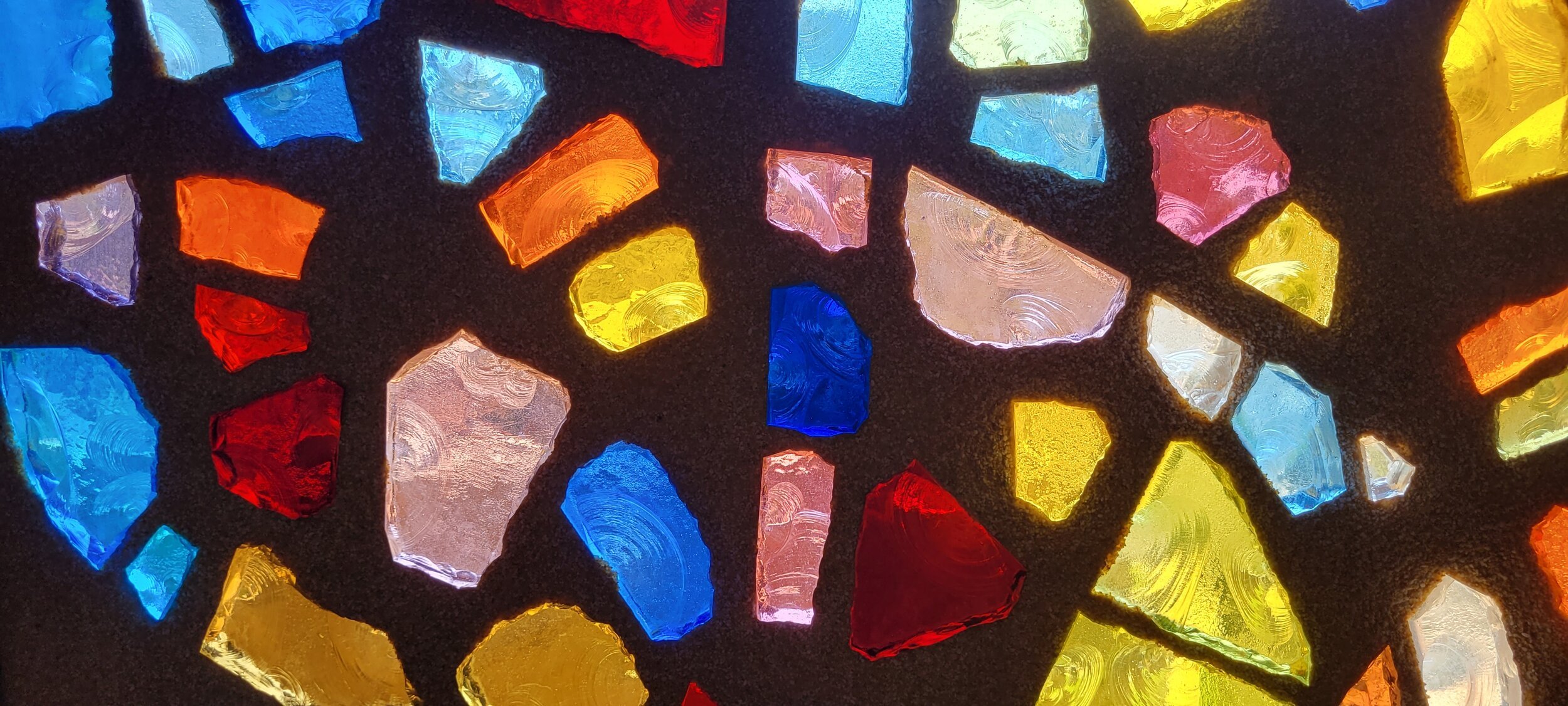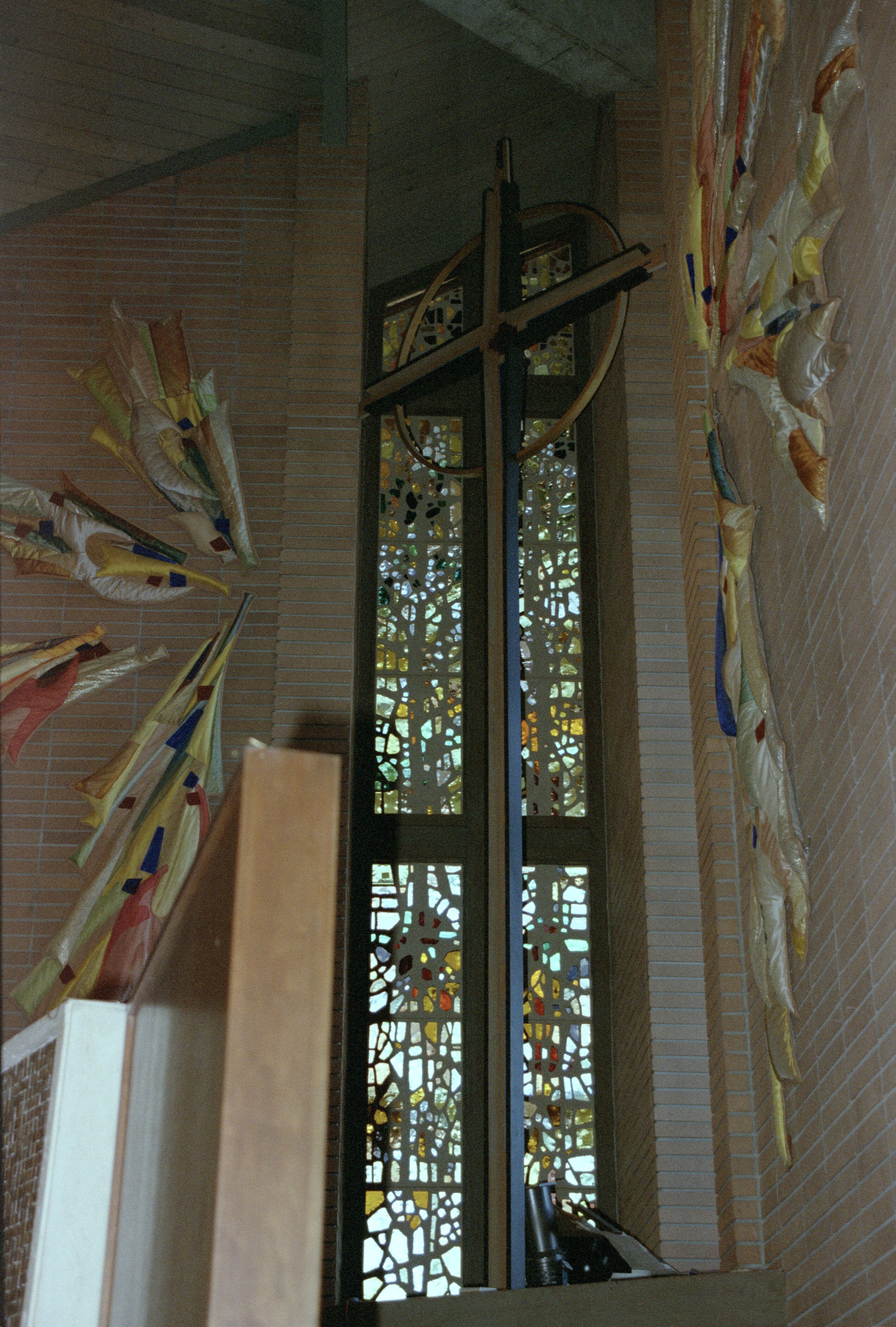
Stained Glass Windows of Christ Church
Gabriel Loire Windows
In 1984 Gabriel Loire, a renowned stained glass artist from Chartres, France visited California. He loved the area and was particularly impressed by the wide variety of trees, from palms to redwoods. Loire designed windows for more than 1,000 churches; in the San Francisco Bay Area he is best known for the great rose window of Grace Cathedral in San Francisco. Even larger than that rose window are the "Four Seasons" window walls of Christ Episcopal Church in Los Altos, which Loire named “L’Arbre” for the trees featured throughout the windows.
Four major windows of stained glass, each 12 by 34 feet, actually comprise the walls of the church. Each window is devoted to one of the seasons of the year, and is also representative of one of the seasons of human life. In addition, two lanced windows, each 24 by 6 feet, represent the Resurrection and celebration of New Life.
The type of stained glass chosen for the project is faceted dalle de verre, or “paving stones of glass” (as opposed to traditional leaded glass) and was selected to match the contemporary style of the architecture of the church. The glass is stronger, and the thickness of the glass, which is faceted when cut, gives what Loire calls “amplitude”. The glass is set in expoxy, giving it a more powerful presence than traditional leaded glass because each line becomes important, separating different colors and becoming part of the design.
Gabriel Loire took an entire year to design the windows, and it took another year to make the windows. Weighing over 19,000 pounds, the windows were shipped from France to the Port of Oakland. Loire’s grandson Herve supervised the installation, which was completed in October of 1986.
Entering the Church
As you enter the church by the central aisle, you can get an overall view of the four large window. As you look at the windows, consider these thoughts expressed by the artist:
“The first general impression is more or less ‘expressionist.’ No single detail should dominate the rest. Rather an atmosphere of peace and joy should suffuse the whole.”
“But in this almost abstract creation there arc many things to be discovered, some which I had in mind, and others which you yourselves may find, discover, or imagine.”
The four main windows are associated with the points on the compass, the seasons of the year, the seasons of human life, the unfolding the biblical narrative from the Creation to the Resurrection of Christ, and Christ's life from The Annunciation to His Death and Burial. The Resurrection (and the return of Spring) is represented in the two lancet windows on either side of the cross.
As you look at the windows, you’ll find many trees. When Loire visited California to prepare to work on the windows, he was awed by the varieties of trees found here. There are seven species of trees shown in the windows: palms, olives, sequoia, sycamore, camphor, apple, and grape vines. In addition, the East window depicts the tree of Jesse.
East Window-Spring
The East Window represents the season of Spring and the season of childhood in human life, and it shows the story of creation. We see the moon and stars, many birds, flowers, and the Pacific Ocean filled with fish, in the lower left side of the window. We see Adam, Eve, and the serpent.
Inspired by Psalm 42, there is a deer drinking from a stream, and a stream of living water flows from the Hand of God. A praying woman stands between two olive trees with the designations “A” and “N,” for Ancien and Nouveau—the Old and New Testaments. The Tree of Jesse springs from the body of Jesse, the father of David and ancestor of Jesus, and the star of Mary is found at the top of the tree. Golden lamps represent the prophets and kings of Judah.
South Window — Summer
The South Window represents the season of Summer and the season of adolescence and young adulthood in human life. This window is filled with blooming flowers, including seven columbines representing the seven gifts of the Holy Spirit. Wheat is growing. Two sequoias, whose bases are hidden behind the choir stalls, send branches spreading throughout the window. A dragon representing chaos is chained to a tree.
At the top of the window is the Sun of Justice, which is surrounded by symbols of the four evangelists, each marked by a cross: John the eagle, Mark the lion, Matthew the man, and Luke the ox. Toward the bottom right of this window is the burning bush revealed to Moses. Toward the upper right is Zacchaeus, the short tax collector who climbed a sycamore tree to see Jesus when He entered Jerusalem.
At the lower right panel of this window is the signature of the artist, Gabriel Loire.
West Window — Autumn
The West Window represents the season of Autumn and the season of middle age in human life.
Toward the left of the window there are 7 crosses, representing the 7 early churches of Asia Minor: Ephesus, Philadelphia, Laodicea, Pergamum, Sardis, Smyrna, and Thyatira. It is the harvest season, and the window is full of bunches of grapes and grapevines and other fruits. A chalice reminds us of communion wine. There are many palm trees. Palms are a symbol of immortality because they are always green, and they remind us of the palm branches strewn before Jesus on the road to Jerusalem.
The dalle de verre technique of using the epoxy as an integral part of the design is accentuated in the West Window, as epoxy depicts the vines and the palm trees, with light shining around the trees.
North Window — Winter
The North Window represents the season of Winter and the season of old age and death in human life. There is great drama in this window. A storm is coming. To the upper left we see the north wind blowing across the setting sun. There is only one tree with green leaves; it is an olive tree in the garden of Gethsemane.
Toward the middle of the window the Last Supper is represented by the symbols of the fish, the chalice and the sacrificial lamb. There is a large crown of thorns near the three red crosses of Calvary. We see the inverted cross of Peter and the X-shaped cross of Andrew. In the lower right of the window is the sepulcher where Jesus was buried, and the ointments brought by the three Marys.
Lancet Windows
Behind the altar there are two 20-foot-tall lancet windows. These windows represent Easter and the resurrection. There are roots and fresh green leaves, representing life and the new life that bursts forth in the spring. At the top of the lancet window to the right is an abstract peacock, another symbol of immortality.


